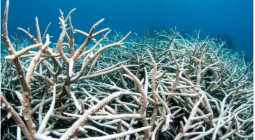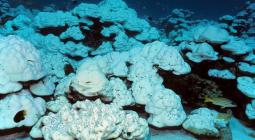Fifth mass coral bleaching event in eight years hits Great Barrier Reef, marine park authority confirms
Particular concern raised for southern areas of the reef that have not been badly bleached since 2016 with ‘high risk’ of significant coral death
The Great Barrier Reef is in the grip of a mass coral bleaching event driven by global heating – the fifth in only eight years – the marine park’s government authority has confirmed.
The authority, together with scientists from the Australian Institute of Marine Science, have completed aerial surveys across 300 reefs over two-thirds of the reef, with more to come.
“These surveys confirm a widespread, often called mass, coral bleaching event is unfolding across the Great Barrier Reef,” the authority said in an update.
Researchers and scientists told Guardian Australia they were devastated by the bleaching, particularly in the reef’s southern section where corals hundreds of years old were severely bleached.
Dr Roger Beeden, the chief scientist at the Great Barrier Reef Marine Park Authority, said: “We now have widespread, often called mass, coral bleaching across the surveyed reefs.”
He said the bleaching was being driven by global heating and an El Niño climate pattern. In-water surveys were ongoing to understand the severity of the bleaching, he said, and in the past the reef had shown resilience.
The Great Barrier Reef – the biggest coral system in the world – is about 2,300km long, covers an area bigger than the size of Italy and is made up of about 3,000 individual reefs.
Widespread mass bleaching of the Great Barrier Reef was first seen in 1998 and happened again in 2002, 2016, 2017, 2020, 2022 and now in 2024.
Ocean temperatures around the world have been the highest on record for almost a year and the US government’s Coral Reef Watch program has said the planet is on the cusp of a fourth global mass coral bleaching event, with reefs in the Atlantic, Pacific and potentially the Indian Ocean all bleaching.
The world’s most southerly coral reef, at Lord Howe Island off Australia’s New South Wales coast, is also being hit by bleaching.
In July, the World Heritage committee will consider if the reef should be placed on a list of sites “in danger” after concerns over the impacts of climate change and pollution and sediment running into the reef’s waters.
Scientists have been warning since the 1990s that as global heating took hold, the world’s coral reefs would be among the earliest ecosystems to be affected.
When corals bleach due to higher than average ocean temperatures, they expel the algae that lives inside them and gives them much of their nutrients and colour.
If temperatures fall, corals can survive but scientists say they tend to be more susceptible to disease and struggle to reproduce. In extreme cases of heat stress, corals can die.
Dr Neal Cantin, senior research scientist at Aims, said: “We now need to combine the spatial coverage captured from the air with in-water surveys to assess the severity of coral bleaching in deeper reef habitats across the different regions of the Marine Park.”
According to Coral Reef Watch data, the heat stress on corals in the reef’s southern and central region has been the highest on record, and the second highest in northern areas.
Diana Kleine, project manager of Coral Watchat the University of Queensland, has been at Heron Island off Gladstone in the reef’s south.
“It’s devastating. Unbelievable. The water was way too warm. Heron has escaped bleaching several times but this year it has hit so hard,” she said.
Coral Watch has observed 4-metre-wide boulder corals that take hundreds of years to grow bleached bone white.
Lyle Vail, co-director of the Australian Museum’s Lizard Island Research Station in the north of the reef, said corals started to show heat stress in early February.
He said: “It’s devastating. Pretty much all of the heat-sensitive corals in the shallow waters have bleached.” He said a small number of corals had died.
The environment minister, Tanya Plibersek, said: “We know the biggest threat to coral reefs worldwide is climate change. The Great Barrier Reef is no exception. It’s essential we do everything we can to protect this amazing place for our kids and grandkids.
“We know Australians, especially local communities and businesses along the Reef, will be concerned by this news. The health of the reef is vital for the 64,000 people who rely on it for work, and the plants and animals that call the reef home.”
She pointed to the government’s legislated target to reach net zero greenhouse gas emissions by 2050, an improved 2030 target, and $1.2bn investment to help the reef adapt to climate change and improve water quality.
Richard Leck, WWF-Australia’s head of oceans, said there was particular concern for the southern areas of the reef that had not been badly bleached since 2016.
“Unless we see a significant drop off in temperatures in the next few weeks, the risk of significant coral mortality is high,” he said.
“Five mass bleaching events in eight years shows that climate change is putting tremendous pressure on the reef.”
He said the federal needed to sharply raise its ambition on cutting greenhouse gas emissions, and Queensland needed to do more to cut deforestation rates.
Dr Lissa Schindler, reef campaigner at the Australian Marine Conservation Society, said: “This is a huge wake-up call for Australia and the global community that we need to do much more to address climate change, which is driving the marine heatwaves that lead to coral bleaching.
“Australia’s current target of a 43% cut in carbon pollution by 2030 is consistent with a 2C warming pathway, which equates to the loss of 99% of the world’s coral reefs.”
Cover photo: The Great Barrier Reef has again been hit by coral bleaching, pictured here off Heron Island. Photograph: CoralWatch




